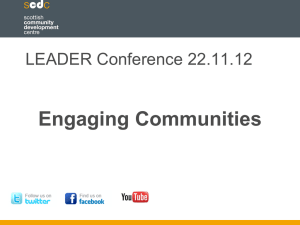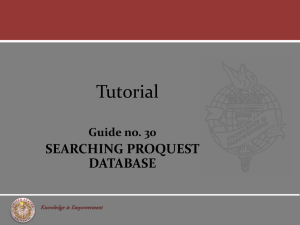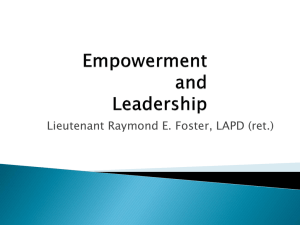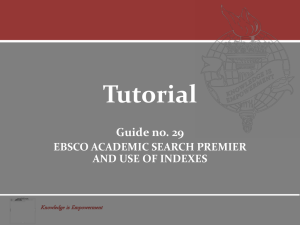Bodily empowerment - Housing Studies Association
advertisement
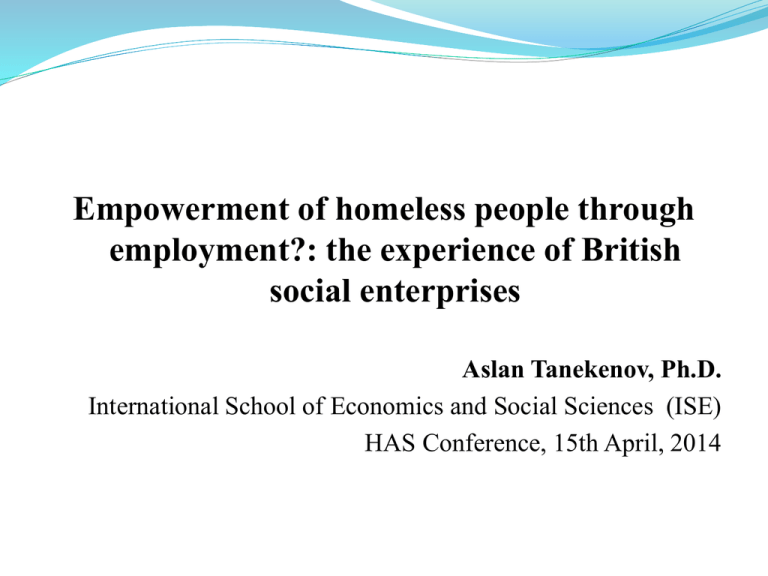
Empowerment of homeless people through employment?: the experience of British social enterprises Aslan Tanekenov, Ph.D. International School of Economics and Social Sciences (ISE) HAS Conference, 15th April, 2014 Outline of presentation: Rationale for Undertaking Current Research and UK Government Policy Research Question Conceptual Framework: ‘Empowerment’, ‘Selfhelp’ and ‘Capabilities’ models Research Methods Key Fieldwork Findings Introduction to Research Rationale for current study UK Government initiatives to support Social Enterprises (SEs) as ‘policy vehicle’ Promotion of integration of homeless people into employment using SEs: New Labour (1997-2010) - ‘Places of Change’ in 2007 & ‘Spark Challenge’ 2008 -2011; Coalition Government (2010-to present) – ‘Big Society’ vision & extension of ‘Spark’ programme The main research question is: How effective are employment-centred social enterprise models in empowering homeless people via enhancing their capabilities? Empowerment Debate The ‘individual’ dimension The ‘collective’ dimension The ‘Individual’ and ‘Collective’ Empowerment Debate ‘Individual’ empowerment ‘Self-help’ ‘Consumer’ model ‘Collective’ Empowerment ‘Citizenship’ model Empowerment aspects that cut across the dichotomy of empowerment ‘Economic’ ‘Political’ ‘Sociopsychological’ ‘Educational’ Weaknesses of Empowerment Models Significantly, however, the empowerment literature fails to adequately capture vulnerable individuals’ diversity, the complexities of difficulties they face, personal ‘conversion’ factors and the impact of context on the extent to which they are (or are not) empowered. ‘Capabilities’ approach In essence, ‘capabilities’ represent “...a person’s freedom to lead one type of life or another” (Sen, 1992, p. 40). In other words, the capabilities approach focuses on the real opportunities we have to accomplish what we value. Sen (1992) terms these accomplishments ‘valuable functionings’. ‘Capabilities’ approach As Hill (2003, p.121) argues: ...the capability approach does not identify the interests of the individual with her stated or revealed preferences. Rather, it assesses the individual’s capability to achieve valued functionings by scrutinizing her situation from different perspectives, in a manner consistent with true interests theory. Nussbaum’s (2000) an operational list of 10 central human capabilities and key domains of life. 1) Life 2) Bodily Health 3) Bodily Integrity 4) Senses, Imagination and Thought 5) Emotions 6) Affiliation 7) Practical Reason 8) Other species 9) Play 10) Control over one’s Environment Table 1. Capabilities-grounded empowerment framework Empowerment domain Capability list Bodily empowerment Life; Bodily health, Bodily Integrity Economic and political empowerment Practical Reason; Control over one’s environment Social and emotional empowerment Affiliation and Emotions Creative and intellectual empowerment Senses; Imagination and Thought Research Methods A qualitative methodology was employed in the study, and in-depth interviews were conducted with 22 key informant stakeholders from social enterprises across the UK, and detailed case studies undertaken of four social enterprises operating within the UK homelessness sector (11 service providers and 23 (ex-) homeless service users were interviewed in site visits to these four social enterprises) Bodily empowerment Somewhat effective with respect to bodily empowerment: it helped to combat substance misuse and improved mental health. However, there was little evidence of an enhancement living environment aspect of bodily empowerment in either those SEs with a social or a business emphasis. Economic and political empowerment The political aspect of empowerment, as opposed to the economic one, was articulated by neither service provider nor any of the homeless people interviewed in this study. Much weaker in the economic empowerment domain (especially with respect to financial independence). Social and emotional empowerment Some homeless people’s abilities to establish and maintain meaningful social relationships with peers in the workplace, friends, and extended family members also appeared improved. Interestingly, almost all of the positive empowerment benefits of SEs for homeless people, particularly the strong benefits noted in the social and emotional realm, were found far more readily in SEs with a social emphasis, rather than those SEs with a business focus, which proposed employment models offering greater individual self-help and responsibilities. Creative and Intellectual Empowerment The evidence suggested that SE service providers totally overlooked the creative and intellectual capabilities of homeless people, but... These aspects of empowerment were noted as being equally as significant as other empowerment dimension by homeless people themselves. It seemed that SEs with a social emphasis had the potential to promote the social, creative and intellectual development of homeless people; this was currently taking place ‘informally’, and unintentionally, ‘on the ground’. The extent that employment-focused SE models can empower homeless people Clearly there were limits to the extent that employment focused SE models can empower homeless people: Homeless people reliance on state benefits during their course of volunteering or being a trainee meant a continued financial dependency which constrained their opportunities to become involved in mainstream social networks and societal activities. Those living in isolation in hostels struggled to leave behind their previous lifestyle and to network with people who had not experienced homelessness. There were cases when projects failed to provide a wide enough choice or level of skills development to satisfy homeless people's desire to gain access to various types of jobs.


